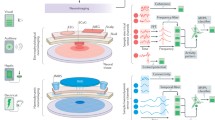Abstract
Nine healthy children took part in five sessions of feedback and instrumental conditioning of slow cortical potentials (SCPs). The feedback conditions (the relation between the feedback signal and amplitude of SCP) were inverted after two sessions. Neither the children nor the therapists were aware of this change. The adjustment of the children to the new feedback setting and the self-regulation strategies employed were investigated. The results were as follows: (a) Healthy children achieved control over cortical negativity within two sessions. (b) The change of feedback conditions worsened the regulation abilities, which then improved again within the following three sessions. (c) After the first two sessions, the participants were able to describe strategies that were successful during different phases of self-regulation. (d) Following the change in the feedback conditions, the children re-evaluated the way they influenced their SCPs. However, they did not alter the cognitive or behavioral strategies. The study demonstrated that positive and negative reinforcement and the knowledge of results are more important for successful self-regulation than the search for effective strategies. The relevance of these findings is discussed.
Similar content being viewed by others
REFERENCES
Basmajian, J. V. (Ed.). (1979). Biofeedback: Principles and practice for clinicians. Baltimore: Williams & Wilkins.
Dunn, T. G., Gillig, S. E., Posner, S. E., Weil, N., & Utz, S. W. (1986). The learning process in biofeedback: Is it feed-forward or biofeedback? Biofeedback and Self-Regulation, 11, 143–156.
Dragoi, V., & Staddon, J. E. (1999). The dynamics of operant conditioning. Psychological Review, 106, 20–61.
Dworkin, B. (1984). Operant mechanisms in physiological regulation. In T. Elber, B. Rockstroh, W. Lutzenberger, & N. Birbaumer (Eds.), Self-regulation of the brain and behavior (pp. 296–310). Berlin: Springer Verlag.
Gelman, R. (1978). Cognitive development. Annuals Review of Psychology, 29, 297–332.
Klein, S. B. (1987). Learning: principles and applications. New York: McGraw-Hill.
Mulholland, T. B. (1984). Concepts of control in biofeedback. In T. Elber, B. Rockstroh, W. Lutzenberger, & N. Birbaumer (Eds.), Self-regulation of the brain and behavior (pp. 277–295). Berlin: Springer Verlag.
Nosofsky, R. M., Palmeri, T. M., & McKinley, S. C. (1994). Rule-plus-exception model of classification learning. Psychological Review, 101, 53–79.
Olson, R. P. (1995). Definitions of biofeedback and applied psychophysiology. In M. S. Schwartz (Ed.), Biofeedback (pp. 27–44). New York: The Guilford Press.
Roberts, L. E., Birbaumer, N., Rockstroh, B., Lutzenberger, W., & Elbert, T. (1989). Self-report during feedback regulation of slow cortical potentials. Psychophysiology, 26, 392–403.
Rockstroh, B. (1987). Operant control of slow brain potentials. In J. N. Hengtgen, D. Hellhammer, & G. Huppmann (Eds.), Advanced Methods in Psychobiology (pp. 179–190). C.J. Hogrefe, Inc.
Rockstroh, B., Elbert, T., Lutzenberger, W., & Birbaumer, N. (1990). Biofeedback: Evaluation and therapy in children with attentional dysfunction. In A. Rothenberger (Ed.), Brain and Behaviour in Child Psychiatry (pp. 345–357). Berlin: Springer Verlag.
Schwartz, N. M., & Schwartz, M. S. (1995). Definitions of biofeedback and applied psychophysiology. In M. S. Schwartz (Ed.), Biofeedback (pp. 32–44). New York: The Guilford Press.
Siniatchkin, M., Hierundar, A., Kropp, P., Kuhnert, R., Gerber, W. D., & Stephani, U. (2000). Self-regulation of slow cortical potentials in children with migraine: An exploratory study. Applied Psychophysiology and Biofeed-back, 25, 15–34.
Utz, S. W. (1994). The effect of instructions on cognitive strategies and performance in biofeedback. Journal of Behavioral Medicine, 17, 291–308.
Author information
Authors and Affiliations
Rights and permissions
About this article
Cite this article
Siniatchkin, M., Kropp, P. & Gerber, WD. Neurofeedback—The Significance of Reinforcement and the Search for an Appropriate Strategy for the Success of Self-regulation. Appl Psychophysiol Biofeedback 25, 167–175 (2000). https://doi.org/10.1023/A:1009502808906
Issue Date:
DOI: https://doi.org/10.1023/A:1009502808906




